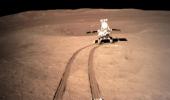Once ISRO masters the technology to send humans into space, the next step will be experimenting with technologies allowing humans to live in space.
T E Narasimhan reports.

The Indian Space Research Organisation has asked researchers to use the fourth stage of its workhorse Polar Satellite Launch Vehicle to find ways to dock a robotic arm with the spacecraft, days after it said it was looking to build a space station within a decade.
The significance is that the fourth stage of the vehicle can be used for the experiments that will be conducted in the space station.
If successful in building its own space station, India will be the fourth country, after Russia, the US, and China, to set up a space station.
In recent years, India's space ambitions have been expanding beyond having planetary missions to talking about anti-satellite missile tests, creating a Defence Space Agency, and now its own space station by 2030.
But what will a space station mean to India and is it worth spending vast sums of money on it?
It's important to understand that space technology impacts our lives in myriad ways, from communications, agriculture management, disaster management, land management, and national security.
Isro's former chairman G Madhavan Nair said establishing a space station is a must for 'keeping the leadership in the space arena'.
A space station is a spacecraft which revolves around the earth and provides a small habitable space for a few humans to live for a few days to carry out cutting edge scientific research in an environment that cannot be simulated on earth.
Currently, the International Space Station (ISS) is the only functional space station in the earth's lower orbit, where at any point in a year, six astronauts conduct experiments in biology, human biology, physics, astronomy, and meteorology.
The 360-tonne space station is circling the earth 400 km above its surface.
The ISS is a multinational collaboration among the European Space Agency, NASA, the Japan Aerospace Exploration Agency, Canada CSA, and Roscosmos of Russia.
Unlike the ISS, India's space station won't be very big; it will probably weigh around 15 to 20 tonnes, it will be used for microgravity tests, and it will be able to accommodate a small group of persons for 15 to 20 days.
ISRO Chairman K Sivan says the plan for India's own space station is a logical extension of the Rs 10,000 crore (Rs 100 billion) human space programme scheduled for 2022.
Without a space station, he said, the human space programme will not have a conclusion.
Once ISRO masters the technology to send humans into space, the next step will be experimenting with technologies allowing humans to live in space.
"Completing the space station in 5 to 7 years will be a challenge, but fortunately ISRO has already been developing technologies, such as the space docking technology, which will help to complete the station on time," said Ajey Lele, senior fellow, Institute for Defence Studies and Analyses.
The space station will be an extension of the Gaganyaan Mission which involves sending three Indian astronauts to space for seven days in lower earth orbit (120 to 400 km).
While this mission will have astronauts who have to drive the spacecraft, the space station may require other human resources for conducting research.
The space station will help to accelerate the development of reusable rockets, in-orbit docking systems, and manned missions.
The station will create new opportunities for other spacecraft to dock as well as allowing for cross-collaboration experiments.
This is important given that, after 2028 when the ISS likely to have been wound up, the only crewed space station is likely to be China's.

While ISRO possesses the technical capabilities, the budget is an issue.
Around $120 billion has been spent on the ISS while the cost of maintaining it annually is around $6 billion to $7 billion.
Though India's space station will not require such a big budget, it will need a significant amount of money.
Rajeswari Pillai Rajagopalan, fellow & head, Nuclear & Space Policy Initiative, Observer Research Foundation, believes that while some understand India's need for a space station, there is also a different view.
"There is a feeling that India has caught the Asian space race fever and that the space station is being taken as a matter of prestige and pride of the country," she said.
"ISRO should collaborate with countries like the US who have the experience and will be comfortable working with India."












 © 2025
© 2025